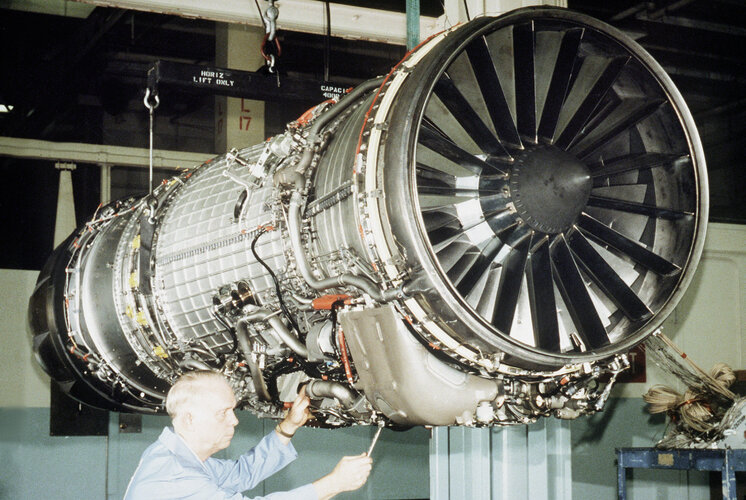Apparently ITAE studied several method to reduce RCS of Su-35 like RAM in inlet duct, gold canopy, plasma radome. But has any of them carry on to production version? https://www.fighter-planes.com/stealth2.htm
You are using an out of date browser. It may not display this or other websites correctly.
You should upgrade or use an alternative browser.
You should upgrade or use an alternative browser.
Has any RCS reduction method ever been implement on production Su-35?
- Thread starter Ronny
- Start date
What is IGV?Supposedly RAM on the inside of the intakes and IGV's. Not sure about canopy, but i think coating on that too.
- Joined
- 15 January 2021
- Messages
- 401
- Reaction score
- 1,476
Inlet Guide Vanes on the engine.What is IGV?Supposedly RAM on the inside of the intakes and IGV's. Not sure about canopy, but i think coating on that too.
These black things right?. Come to think of it, has there ever been any program to paint the IGV of F-110 or F-100 engine with RAM?. Did have glass I, Have glass II and Have glass V include any RAM on engine IGV or only the inlet duct?Inlet Guide Vanes on the engine.What is IGV?Supposedly RAM on the inside of the intakes and IGV's. Not sure about canopy, but i think coating on that too.

- Joined
- 15 January 2021
- Messages
- 401
- Reaction score
- 1,476
Yes, the black struts at the front of the engine fan.These black things right?. Come to think of it, has there ever been any program to paint the IGV of F-110 or F-100 engine with RAM?. Did have glass I, Have glass II and Have glass V include any RAM on engine IGV or only the inlet duct?Inlet Guide Vanes on the engine.What is IGV?Supposedly RAM on the inside of the intakes and IGV's. Not sure about canopy, but i think coating on that too.
View attachment 678005
I am unaware of any RAM coating on the IGV on the F100 or F110 engines for the F-15 or F-16. But, it has been a few years and I am not a F110 expert
It is possible to have RAM coatings on the fixed IGV and variable angle trailing edge flaps, but it has to be designed for the coating right from the beginning to effectively reduce RCS and to keep the coatings intact. Remember that if these coatings are liberated at these location, it is immediately ingested into the engine, likely causing significant damage to the rapidly spinning airfoils of the fan and compressor.
Why can't they just use the same type of RAM that they would put on the inlet duct? Both the IGV and inlet duct are stationary right?. Come to think of it, does Have glass actually include any RAM in the inlet duct?Yes, the black struts at the front of the engine fan.
I am unaware of any RAM coating on the IGV on the F100 or F110 engines for the F-15 or F-16. But, it has been a few years and I am not a F110 expert
It is possible to have RAM coatings on the fixed IGV and variable angle trailing edge flaps, but it has to be designed for the coating right from the beginning to effectively reduce RCS and to keep the coatings intact. Remember that if these coatings are liberated at these location, it is immediately ingested into the engine, likely causing significant damage to the rapidly spinning airfoils of the fan and compressor.
- Joined
- 15 January 2021
- Messages
- 401
- Reaction score
- 1,476
Remember that RAM is not just paint, it has a non-trivial thickness. If you were to add it to the duct, it would have little aero effect. But the IGV are airfoils used for specific aero purposes and adding that thickness could easily reduce the performance and / or operability of the engine if it isn’t part of the original design. Signature reduction of the propulsion system is a multi-discipline integration of aero, shaping, and coating design.Why can't they just use the same type of RAM that they would put on the inlet duct? Both the IGV and inlet duct are stationary right?. Come to think of it, does Have glass actually include any RAM in the inlet duct?Yes, the black struts at the front of the engine fan.
I am unaware of any RAM coating on the IGV on the F100 or F110 engines for the F-15 or F-16. But, it has been a few years and I am not a F110 expert
It is possible to have RAM coatings on the fixed IGV and variable angle trailing edge flaps, but it has to be designed for the coating right from the beginning to effectively reduce RCS and to keep the coatings intact. Remember that if these coatings are liberated at these location, it is immediately ingested into the engine, likely causing significant damage to the rapidly spinning airfoils of the fan and compressor.
Similar threads
-
-
Speculative/fictional Su-57 production version
- Started by Trident
- Replies: 17
-
-
-
